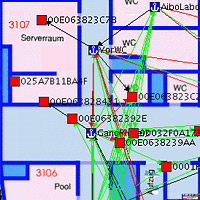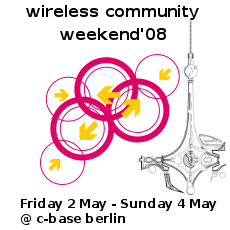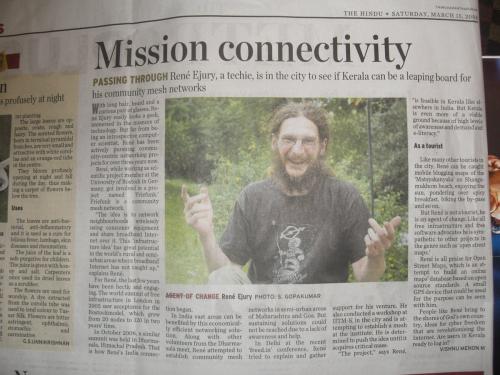The first english Videocast of Flo Fleissig with Kloschi (Freifunk), Kurt Jansson (Wikimedia), Jürgen Neumann (Freifunk), Rishab Aiyer Ghosh (United Nations University), Lawrence Lessig (Creative Commons) and Allison and Benoit (Montréal Wireless)
Direct Videolink: http://video.google.de/videoplay?docid=-345577071434265096
Production: Mario Behling
"Hello this is Flo!" .. from the free culture, free software, free infrastructure conference Wizards of OS in Berlin. "It is good stuff you can do here. There are excellent panels with excellent people from all over the world." And Flo is gonna go out to interview some of those excellent people. Watch how Flo talks with Kloschi, Freifunk activist and developer from Leipzig (Germany), finds out that Kurt Jansson, head of the Wikimedia association in Germany, uses the same Freifunk gateway as himself or learns about the early days of free infrastructures in Germany by talking to Jürgen Neumann one of the "founding fathers" of the Freifunk community. Further on Rishab Ghosh from the United Nations University in Maastricht explains how open content and open infrastructure are closely related, before he gets an overview of the development of the world’s biggest wireless network in Berlin by Flo … And of course he also gets to know where he finds Flo’s node in the network. Also, Lawrence Lessig from Stanford University and Creative Commons (and without name tag) describes the free network project in Berlin as “an extremely important project to liberate the physical layer right now.” Flo: “Thank you Larry … and here is your name tag, which I found.” Finally Allison and Benoit from free wireless community in Montréal explain about different models to share and give us a few insights into the chances and difficulties you face when you try to establish a free and open network.
Flo firstly conducts an interview with Kloschi, one of the developers of the Freifunk Firmware and network builder from Leipzig. Flo: “What can you tell us about Freifunk at the conference?” Kloschi: “We have a long shot through this area. It is 6 km … and we get Internet from over there. It is rock solid mesh!” Flo: “Wow! Great! And what are you interested in at the conference?” Kloschi: “I am really interested in the community activism and in the open source business model… How does it sustainably and positively integrate – to have a survival in a commercial world and still going the free or open way…”
Kurt Jansson (head of the Wikimedia association in Germany), talks about the connection of open content, free licences, free and open source software and the development of free infrastructures. Freifunk… "I am using it when I am out in the park and I site there in the green and edit Wikipedia. I think it is a great way to give access to people." By the way the favourite article of Kurt on Wikipedia is "French Kissing".
Then Jürgen Neumann, one of the brilliant people who initially came up with the idea of Freifunk in Germany explains more about the idea behind free wireless infrastructures: "The idea is to have a local wireless network, which is run by the users, where people just add their own access point to the network. It becomes part of the infrastructure. Between all these access points they have their own network. They can do whatever they want with this network. There is no regulation. They have a symmetric connection. They can share information. They can use VoIP and everything for free."
Following Jürgen, Rishab Aiyer Ghosh from the United Nations University in Maastricht and founder the most widely read peer-reviewed on-line journal of the Internet First Monday shows the relationship and the commons and differences of free and open content and infrastructures: "Open content and open infrastructure are fairly close related. When you got open content you need to distribute it somewhere and there is no point of having open content if nobody can access it or there is high barrier to access it. … The main thing about content is, when you contribute and collaborate content it can be copied many times. With infrastructure on the other hand it is hard. Once you got infrastructure you can’t duplicate it. It actually costs money. …What you can do by opening it, you allow many more people to access the infrastructure once you paid for it already. … It does not matter to you if one person using it or a hundred… But it provides a benefit to a lot of people."
Lawrence Lessig (without name tag) from Stanford University and Creative Commons and one of the biggest open source persons in the world underlines the importance openness in every layer: "It is extraordinarily important to have openness really in every layer of the network. The physical infrastructure needs to have open and free resources, the logical and the application … needs to be open and the content layer too has to be open. These things work together to encourage a wide range of innovation and creativity. So it is an extremely important project to liberate the physical layer right now." Flo: “Thank you Larry … and here is your name tag, which I found.”
Finally Allison and Benoit from free wireless community in Montréal talk about their new project to create an island without wires and their idea of a mesh network. So far they could already set up about 120 hot spots in public places. Benoit also explains the difficulties to share in a mesh network and the need to establish a network in a sociological sense as well. Benoit: "I am a bit disillusioned… I am really looking forward with meeting the Freifunk people to see how they made a mesh sociological successful…. because I kind of don’t believe in it anymore. So I am looking for some fresh ideas." Flo: "… Hey! We all wanna share.. Hm.. Maybe not…" Allison: "I think sharing is good, but I think there are different kinds of models to share… another kind of model to share… it is a model to create a space for sharing for people … If they are in their favourite café, (our) captive portal page gives them a kind of identified virtual space that goes along with the physical space they share."
 Thee free wireless community is growing and for some time I tried to keep a list of communities on the Global Newswire Site at http://global.freifunk.net/free_global_wireless_community. The bigger the community gets the more difficult it becomes. Instead of maintaining a seperate list of freifunk communities I will join the maintainers of a list of communities in the English Wikipedia, who have created a wiki page here: List of wireless community networks by region.
Thee free wireless community is growing and for some time I tried to keep a list of communities on the Global Newswire Site at http://global.freifunk.net/free_global_wireless_community. The bigger the community gets the more difficult it becomes. Instead of maintaining a seperate list of freifunk communities I will join the maintainers of a list of communities in the English Wikipedia, who have created a wiki page here: List of wireless community networks by region.


